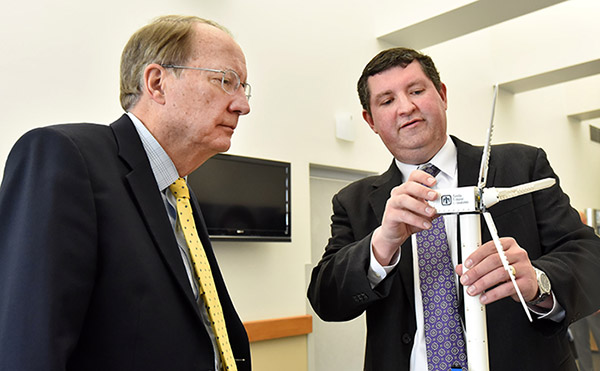FY17 budget request reflects the administration’s ‘unwavering commitment’ to NNSA’s mission, Lt. Gen. Klotz says at all-hands meeting

BEFORE AN ALL-HANDS MEETING with Sandia employees, NNSA Administrator Lt. Gen. Frank Klotz was briefed by researcher Todd Griffiths on Sandia’s work related to offshore wind energy technologies.
Lt. Gen. Frank Klotz, DOE’s Under Secretary for Nuclear Security and Administrator of the National Nuclear Security Administration, brought an upbeat message about the president’s FY17 NNSA budget request to Sandia during an all-hands meeting in March. The proposed budget represents a nearly 3 percent increase over the FY16 budget.
In remarks delivered at the Steve Schiff Auditorium (and videostreamed to Sandia/California and other Sandia locations), Klotz said, “Your constancy of purpose allowed us to achieve some significant milestones last year, and puts us in a strong position to continue that success in 2016 and beyond.”
A vote of confidence
The FY17 budget request, Klotz noted, is the president’s proposal to Congress, which has the ultimate approval authority. The proposed budget, he said, is a vote of confidence and indication of the administration’s continued “unwavering commitment” to NNSA’s enduring missions: to maintain a safe, secure, and effective nuclear weapons stockpile; to prevent, counter, and respond to the threat of nuclear proliferation and nuclear terrorism around the world; and to provide operational support for naval nuclear propulsion plants.
Klotz said that when put in perspective, the proposed budget increase is substantial.
“I ask you to look across the entire range of government agencies in a time of fiscal austerity and find many other agencies that have a flat budget, much less an increasing budget. I think that speaks to the importance of our missions, of what you do for the benefit of our national security.”
NNSA’s proposed budget supports continued work on three major life extension programs (LEPs) — the W76-1, W80-4, and B61-12 — and one major ALT program, the W88 ALT 370, a scope of weapon-related work not seen since the end of the Cold War.
Proven success
“Last year,” Klotz said, “our science-based Stockpile Stewardship Program allowed the secretary of Energy and the secretary of Defense, based on the assessments of the lab directors, including your lab director, to certify to the president for the 20th year in a row that America’s nuclear weapon stockpile remains safe, secure, and reliable without the need for underground explosive nuclear testing.
“The proven success of the Stockpile Stewardship Program is made possible each year by the essential investment in the state-of-the-art diagnostic tools, high-performance computing, and modern facilities and capabilities that enable you, the talented scientists, engineers, technicians, and administrators, to carry out the work of NNSA. This year’s budget request seeks to build on that success and position us not just for the coming fiscal year but for the Stockpile Stewardship Program of the next two decades.”
‘Pointy end of the spear’
Klotz noted that the budget incorporates almost $900 million to address aging infrastructure concerns and halt the growth of deferred maintenance of critical facilities and resources, a perennial problem, and one not limited to NNSA.
“In my nearly 40 years of active duty,” he said, “I observe over and over and over again that the first dollars always go to the pointy end of the spear and the people who hold the spear. And every year, decision makers will say, ‘I’d like to spend some money to buy down deferred maintenance or backlog of maintenance and repair, but I can’t afford it this year, so I’ll take a risk for one more year.’
“Well, one more year becomes two more years, becomes three more years, becomes 10 more years, and ultimately you get to a tipping point. And then you just have to bite the bullet and spend the money it takes to replace the infrastructure.”
Following a slide presentation of the proposed overall budget and its individual components, Klotz said, “You may have noticed that there is a decrease of almost 7 percent (for the Defense Nuclear Nonproliferation program]. There are those who would just look at the bottom line number and say, ‘Wait a minute. Does this mean that the NNSA, the DOE, the administration, are backing off on the importance they attach to nuclear nonproliferation and reducing nuclear dangers around the world?’ I have to say, no, not in the least.”
Committed to nonproliferation efforts
Klotz noted that the reduction reflects the fact that there were significant carryover funds from FY16 in the nonproliferation account, explained mostly by two specific factors.
First, Russia, a partner in nonproliferation efforts since the end of the Cold War, ended its cooperative relationship with the US in the program. As such, some of the FY16 funds that had been allocated for work with Russia were not spent and became available for FY17.
Also, under the terms of a 2000 agreement with Russia, amended in 2010, both parties agreed to dispose of 34 metric tons of excess weapons-grade plutonium. After extensive study, NNSA has decided to adopt a disposal technology that is considerably faster and cheaper than alternatives that had previously been considered. The FY17 budget reflects the decision to adopt the less expensive disposal approach.
“The real story, the rest of the story,” Klotz said, “is that we are no less committed to nuclear nonproliferation than we were in the past.”
Klotz said that in presentations to congressional committees regarding the budget request he has seen “enthusiastic support for what we’re proposing on both sides of the aisle, on both sides of Capitol Hill. I’m very optimistic that the Congress will be supportive of most if not of all of what we have sent up to them.”
In closing, Klotz invited the audience to check out his Twitter account at @FrankKlotzNNSA.